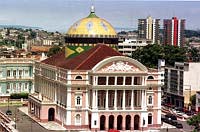 But this time now as we were driven from the airport to our hotel we could have been in any big Brazilian city. High rise blocks of flats shopping centres, road viaducts, traffic jams, dust and noise. You got no feeling that you were in the middle of the world’s biggest tropical forest or on the edge of the world’s mightiest river.
But this time now as we were driven from the airport to our hotel we could have been in any big Brazilian city. High rise blocks of flats shopping centres, road viaducts, traffic jams, dust and noise. You got no feeling that you were in the middle of the world’s biggest tropical forest or on the edge of the world’s mightiest river.
On the last night of the conference they took us to have dinner in the gardens of the luxurious Rio Negro palacete. The palace was built 100 years ago by a German rubber baron called Waldemar Scholz When rubber prices crashed he had to sell it. Now it’s a museum. Next to the palace was a new park, full of children’s swings and – I couldnt believe it – concrete trees! In the middle of the Amazon they had created a park with concrete trees.
Suframa, the agency that controls the Free Zone of Manaus, was holding its 4th international trade fair – stand after stand of electronic and electrical products. Again, it could have been anywhere, except for a forlorn group of four indians – a middle aged couple and their two teenage sons – waiting to perform a dance. Painted and befeathered, they came from the Tariana group who live on the border of Brazil and Colombia. They seemed lost among the razzmatazz of the Fair, among the suits, and high heels and mobile phones. But talking to them I discovered that they were quite pragmatic. The couple said they had moved to Manaus so their sons could get a university education. Back in the village there had only been a primary school. They would go back once their sons were educated. But would the sons?
This constant migration from the forest to the city has swollen the population of Manaus to nearly two million people. The factories of the Free Trade Zone, which was set up in 1969, have provided an irresistible lure. For its supporters the existence of the Zone has also helped to save the forest, by providing alternative economic opportunities to logging it.
But while Manaus has turned its back on the river and become a nondescript city of factories and urban problems, it’s also the lack of roads in the vast state of Amazonas that has helped to keep the rainforest largely intact. In the Amazon, the river has always been the highway.
But the pressure to link Manaus to the rest of Brazil by road is growing.
A dirt road connecting Manaus to Porto Velho, the capital of Rondonia, already exists. Its called the BR319, but most of it has been washed away by rains and neglect. Now Lula’s Transport Minister, Alfredo Nascimento, is keen for it to be paved, because it would also pave his way to becoming governor of Amazonas state in next year’s elections.
Once paved, it will provide easy access to the relatively untouched rainforest in the Western amazon. Experience of other Amazon roads has shown that even when conservation areas and national parks are created along them, the loggers will invade them. One of the powerful arguments for paving the 319 is that it will enable the producers of Mato Grosso to export their soya more cheaply. But there is another easier solution, defended by people like ecologist Philip Fearnside, who’s studied the Amazon for 40 years. It is to use the River Madeira, which flows from Porto Velho to Manaus and improve port facilities at Itacoatiara.
These debates inside Brazil are the backdrop to Brazil’s environmental stance. At Copenhagen preserving the rainforests is an abstract idea, but on the ground here, the Amazon is full of people who have their own conflicting ideas, and their own political agendas, about what should be done.
Audio podcast

